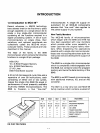
INTRODUCTION
Memory Write
A memory write operation
is
similar to a read
except for the direction of data
flow. The
CPU issues a write signal, sends the proper
memory address, then sends the data word
to be written into the addressed data memory
location.
Input/Output
Input and Output operations are similar to
memory read and write operations with the
exception that
an
I/O
port is addressed
instead of a memory location. The CPU
issues the appropriate input
or
output
control signal, sends the proper address and
either receives the data being input
or
sends
the data
to
be output.
Data can be input/output in either
parallel
or
serial form. All data within a digital computer
is
represented in binary coded form. A binary
data word consists
of
a group of bits; each bit
is
either a one
or
Ii
zero. Parallel I/O consists
of
transferring all bits
in
the word at the same
time, one bit per
line. Serial I/O consists
of
transferring one bit at a time on a single line.
Naturally serial I/O
is
much slower, but it
requires considerable less hardware than
does
parallel I/O.
Interrupts
Interrupt provisions are included on many
central processors,
asa
means
of
improving
1·9
the processor's efficiency. Consider the case
of
a computer that
is
processing a large
volume of data, portions
of
which are to be
output to a printer. The CPU can output a
byte
of
data within asingle machine cycle but
it may take the printer the equivalent
of
many
machine cycles to
actually print the char-
acter specified by the data byte. The CPU
could then remain idle waiting until the
printer can accept the next data byte.
If
an
interrupt capability
is
implemented on the
computer, the CPU can output a data byte
then return to data processing. When the
printer
is
ready to accept the next data byte, it
can request
an
interrupt. When the CPU
acknowledges the interrupt, it suspends
main program execution and automatically
branches to a routine that
will output the next
data byte. After the byte is output, the CPU
continues with main program execution.
Note that this
is,
in principle,
quitesimilarto
a
subroutine
call, except that the
jump
is
initiated externally rather than by the
program.
More complex interrupt structures are
possible, in which several interrupting
devices share the same processor but have
different priority
levels. Interruptive proces-
sing
is
an
important feature that enables
maximum
utilization
of
a processor's capa-
city
for
high system throughput.


















